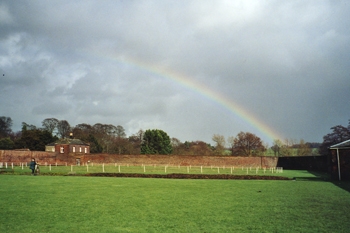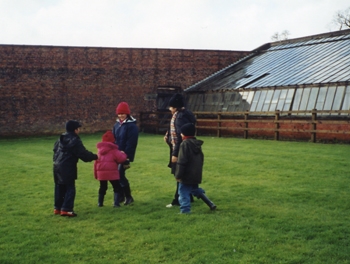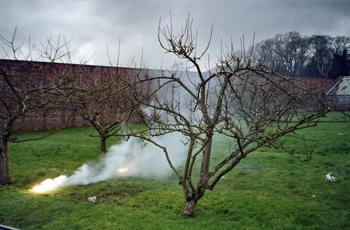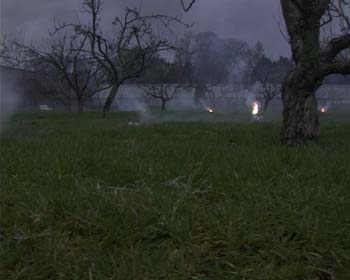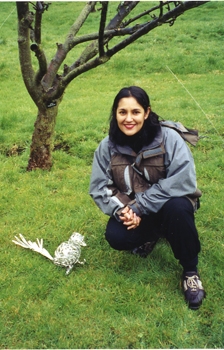Feature: Essays
About Magnesium Bird
TWO JOURNAL ENTRIES, AN EMAIL EXCHANGE AND A POSTSCRIPT
MARCH 21-MAY 12, 2004
March 21, 2004
On the train back to London from Leeds, I sort out memories and impressions of yesterday’s miraculous event: the staging of Sutapa Biswas’s Magnesium Bird in Harewood’s walled garden.
The weather was almost willfully changeable with intermittent intense showers and sudden gusts of wind, alternating with sunshine and blue skies, and a short-lived rainbow.
In the morning the production team of some ten people (including a special effects expert), with vehicles and equipment, traipsed around in the mud and rain, checking this and that, including counting the number (43) of magnesium birds that had been made (primarily by Biswas’s assistants), and deciding on the “best” for the front row of the installation. The small birds were made out of thin strips of magnesium ribbon that had been modeled into birds with long tails. They ranged widely not only in size, shape and density, but also in elegance.
Around noon excitable children, accompanied by their parents, arrived to perform in the afternoon’s event. For several hours, the seven kids played almost continuously at the far end of the orchard in front of the greenhouses (a mike had been set up to catch their voices). With Enzo Biswas-Rodgers were his six young cousins (Debjani and Rahoul Biswas-Hawkes, Aparna and Sudipto Biswas and Maya and Uma Whittaker) who ran high-spiritedly to and fro. All were attired in warm clothes, with dashes of red here and there.
There was (intentionally) no audience for this event.
Four “takes” of the event were recorded in both digital video and 16 mm film. Each time, ten magnesium birds were placed in a certain pattern (which Biswas designated as a “constellation”) in the grass beneath the still-barren orchard trees, and set up, with charges at the bases, so that the birds would ignite separately rather than flare up simultaneously.
Bright flames appeared here and there until all the birds were lit. Then soft smoke billowed in the wind, until both the fire and the smoke died down. All that remained were ten smoldering forms of the once-silver birds. Finally their gray-ashes were swept up, leaving small burned areas which were covered with chunks of grass-covered earth . . . the cycle was repeated three more times (the first shoot was around 2:30 PM and the last at 4:30 PM.)
For a brief time the orchard was transformed into a supernatural world of magical birds and mythic children, a world of fire and smoke . . .
then . . . ashes to ashes, dust to dust . . .
March 22, 2004
On the flight back to California from London, I think about the future of Magnesium Bird.
How will the footage be distilled during the next few weeks of editing? What images and sounds will be chosen? Will only a single “take”’ be selected, or more? And if so, how will the juxtaposition of different “takes”’ affect one another? Will the film be the duration of a “take,” which lasted only two minutes and forty seconds each time? Who will see the film and in what circumstances - an art gallery? A film festival? Or privately at home on a video or DVD? And how will the film be read by its various viewers and critics?
Will ghosts watch it, too?
Frantz Fanon?
Marcel Proust?
E-mail message from Sutapa Biswas
April 13, 2004
“Both the 16mm format and the high-end digital format worked beautifully, but in the end I have decided to go for the latter as it looked amazing - as if it had been shot on 35mm format. As yet, the piece will be 38 seconds long, with short black intervals between. The idea is to “replicate” the feeling and time taken for magnesium to burn.
It looks amazing, like a moment from a Tarkovsky film. It will work really beautifully alongside Birdsong [Biswas’s other recent film] which has a slower pace.”
“In response to your question about Magnesium Bird, we have as yet not completely finalised the edit. But at this stage we are hoping to use the sound of the children. We have taken out any recognisable conversation, but have tried to keep the general pitch of hearing children at play in a distant playground from afar. Nothing too pronounced or located. It is quite a strange but beautiful sound.”
E-mail message from Sutapa Biswas
April 30, 2004
“On Thursday this week, we completed the final edit for Magnesium Bird. It is truly magnificent, and so very haunting. Just like my lucid dream in Oslo. The sound is incredible. The children play and their muffled sounds are heard, occasionally interspersed by the odd audible word. The sound track is about four minutes in length, and the visuals fit into this, each visual edit lasting about 38 seconds followed by a brief fading to black and then re-emergence and repetition. It is stunning, and I can’t wait for you to see it, Moira.”
POSTSCRIPT, May 12, 2004
Sutapa Biswas is a major English artist who has been working in a variety of mediums (painting, drawing, installation, performance, video and film) since the mid-1980s, creating work that draws upon many different interests, ranging from postcolonial theory to film history to autobiography to a love of the writings of Marcel Proust and Frantz Fanon to the films of Cocteau and Tarkovsky to . . .
In March 2004, Magnesium Bird was staged and shot in a lavish eighteenth-century walled garden in Harewood House, a huge country estate in Northern England. This new work is included in Biswas’s 2004 traveling exhibition sponsored by the London-based Institute of International Visual Arts (inIVA), and accompanied by a substantial book-catalog [Ian Baucom et al, Sutapa Biswas, London: inIVA, 2004] that includes writings by Griselda Pollock, Laura Mulvey, Stephanie Snyder, Guy Brett, Ian Baucom and myself.
In my essay, “Sutapa Biswas: Flights of Memory/Rites of Passage/Assertions of Culture, A five-part study,” I describe the context and evolution of Magnesium Bird which at the time of writing had not yet been filmed (hence the description of this event was not included in that publication) although I had accompanied the artist up North for a trial run of the event in January, 2004. I had, however, become so fascinated by the piece that I wanted to see its actual staging, and accordingly made a flying visit in March from California to England to see the event.
***
Birdsong, a two-screen film installation by Sutapa Biswas, opened at Cafe Gallery Projects in London May 26 and will be on view through June 20, 2004. For more information, visit the gallery Web site or call +44 (0)20 7237 1230.
Text and Photographs by Moira Roth, © Moira Roth, 2004

